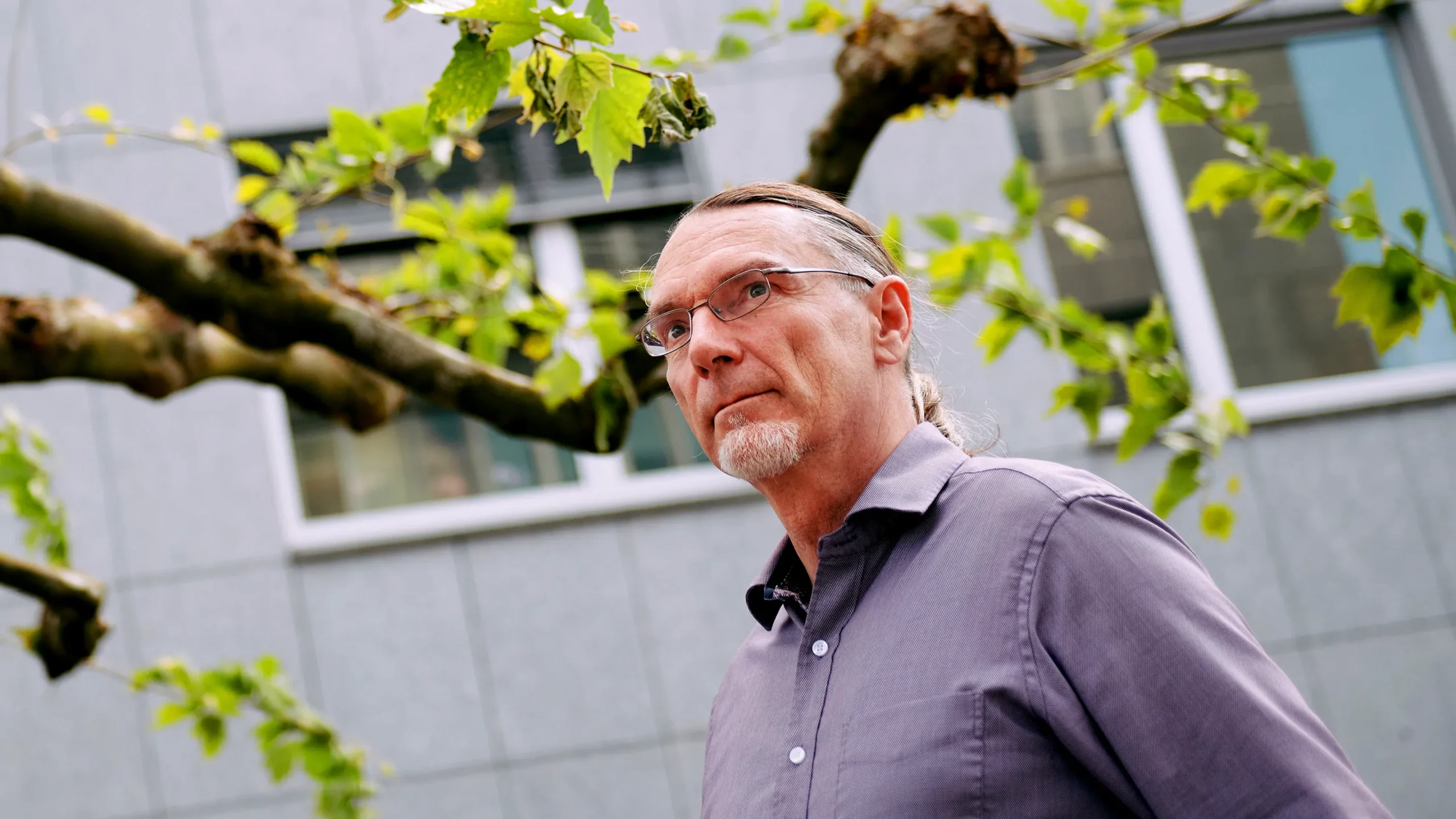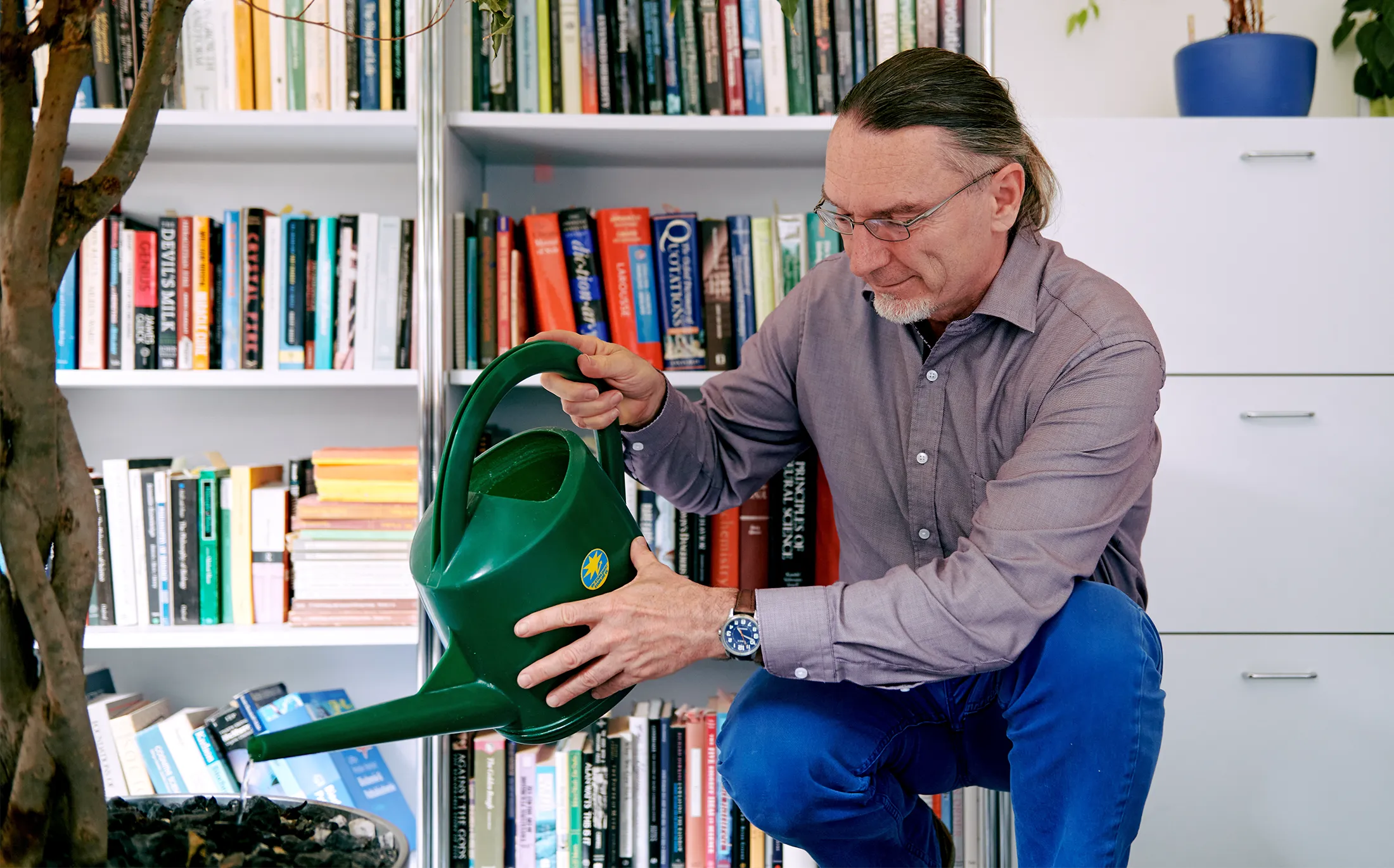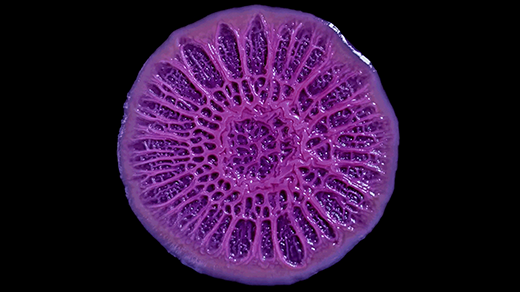Andreas Wagner Pursues the Secrets to Evolutionary Success

The evolutionary biologist Andreas Wagner has made it his life’s work to study “robustness” in evolution — the quality that enables species to survive and adapt in the face of challenges.
Thi My Lien Nguyen for Quanta Magazine
Introduction
Every organism responds to the world with an intricate cascade of biochemistry. There’s a source of heat here, a faint scent of food there, or the crack of a twig as something moves nearby. Each stimulus can trigger the rise of one set of molecules in an animal’s body and perhaps the fall of others. The effect ramifies, tripping feedback loops and flipping switches, until a bird leaps into the air or a bee alights on a flower. It’s a vision of biology that entranced Andreas Wagner, an evolutionary biologist at the University of Zurich, when he was still a young student.
“I thought that was much more fascinating than this idea that biology is about counting the number of things that are out there,” he said. “I realized biology could be about fundamental principles of organization in living systems.”
His career, which has included stints at the Santa Fe Institute and the Institute for Advanced Study in Berlin, has taken him from modeling the regulation of gene transcription in an embryo, where precision timing makes the difference between life and death, to asking how an organism can manage to evolve when any change in its genes could spell disaster. He has used theoretical models to probe difficult questions about what drives evolution, and he has wondered about evolutionary innovations that seem to lead nowhere — until they suddenly become the next big thing. His most recent book, Sleeping Beauties: The Mystery of Dormant Innovations in Nature and Culture (Oneworld Publications, 2023), is an exploration of this phenomenon.
Quanta spoke to Wagner over the phone recently about his new book, evolution as exploration, and the grand patterns that underlie biology. The interview has been condensed and edited for clarity.
When I first met you about 10 years ago, you were talking about the paradox of trying to evolve an organism: How can changes occur in a working genome without everything falling apart? How did you come to focus on that problem?
I remember a conversation with somebody many years ago where we were discussing why organisms are diploid — that is, why do they have two copies of their genes? I said, “Maybe because if one copy is defective due to mutation, the other one provides a backup.” And the other person said, “No, this would be too simplistic.” I didn’t find out until 20 years later that I was probably onto something there, because there’s now been a lot of work that suggests this could be one of the reasons why diploidy is abundant in nature. That was the first link to this concept of robustness: that diploidy can provide organisms with robustness to mutations.
It’s something that I rediscovered when I started working on gene regulatory networks. These model networks evolve through mutation and selection, and over time they become increasingly robust against disruptions by mutations. I became really fascinated with that.
I realized that this kind of robustness could be linked to the ability of populations to explore many, many different genotypes during evolution without losing a phenotype that’s well adapted. In doing so they could stumble on new phenotypes that they would not be able to otherwise. I’m still fascinated by this link between the ability of biological systems to withstand perturbations — for example, mutations — and their ability to explore new things.

“We can think of evolution as the exploration of a space of genotypes,” Wagner said. “We can study the ability of organisms to adapt by understanding how the space is organized.”
Thi My Lien Nguyen for Quanta Magazine
So this is something going on below the obvious level, right? You don’t necessarily notice it if you’re looking at an individual or a population, but you might notice if you looked at generation after generation.
Yes. Perceiving this robustness requires you to look under the surface. We and others have discovered this now in a lot of different systems. It seems to be something fairly general that applies on multiple levels of organization. I’m fascinated by principles that don’t apply just to one organism or one kind of system but could work at multiple different levels of organization. And this is one candidate.
When you first set up your lab at the University of Zurich, what did you do to continue exploring these ideas?
Here is one of our first experiments: Somebody had discovered that when the bacterium Escherichia coli enters the human intestinal tract, the environment contains oxygen. But as it gets deeper into the bowel, the environment starts to lack oxygen. E. coli needs to express different genes depending on whether oxygen is there or not.
It turns out E. coli has evolved this anticipatory response where as soon as it enters the gastrointestinal tract, it starts to turn on the needed genes before it hits the anoxic zone. Its foresight might have evolved out of the thousands of millions of times it has gone through intestinal tracts: When it gets warm or the pH drops, or whatever it is, then it needs to turn on these genes, because soon it’s going to run out of oxygen.
We wanted to find out whether you could evolve something like that in the laboratory. So we cycled yeast between different stressful environments. Once yeast went through the cycle multiple times, would they start to turn on the genes for handling oxidative stress [from too much reactive oxygen] before the oxidative stress hit? We found some evidence that they did.
It was the kind of experiment that I like to work on that’s very simple in principle and that is about a fundamental idea — in this case, can even very simple organisms anticipate the future?
Would you say that the ideas in your first book, Arrival of the Fittest (Penguin Random House, 2015) were drawn from what you’d been doing in the lab?
These experiments certainly informed some of what I wrote in the book. But it was not really the experiments that drove the book. It was really this fundamental idea that we can think of evolution as the exploration of a space of genotypes. We can study the ability of organisms to adapt by understanding how the space is organized. Are all genotypes with one phenotype in one corner of that space? Or are they sort of scattered through the space? I thought it was an important idea, and nobody had written about it.

Wagner has recently written about the groups of organisms that he calls “sleeping beauties” — organisms that were not particularly successful when they first appeared but exploded in numbers and variety much later.
Thi My Lien Nguyen for Quanta Magazine
So the idea is that different versions of genes can affect organisms’ evolutionary fitness, and this can be plotted in terms of a fitness landscape. Can you please explain what a fitness landscape is?
A fitness landscape is an analogue of a physical landscape where each location corresponds to a genotype — a DNA sequence, perhaps for just a single gene. And the elevation at that location corresponds to some measure of quality — for example, fitness or the ability of an enzyme to catalyze a reaction or do something else important for the organism.
This is a foundational concept in evolutionary biology. But there was only theory in that area for close to 80 years. Thousands of papers have been published about what these landscapes might look like, but there’s very, very little experimental work in that area.
That started to change a bit in the early 2000s. People started to create collections of genotypes and studied their phenotypes. These first landscapes comprised only about 20 to 40 or so genotypes. Small compared to these astronomical numbers of genotypes that we have in our genomes. And it was fascinating, but I felt we could probably do better — that we could create and study many more large landscapes, and perhaps address the big question: How do evolving populations find the highest peaks in such a landscape and become best adapted to a particular environment?
Why is that a hard question?
If a landscape is smooth, what’s been called a Mount Fuji landscape, there’s a single peak, and all slopes going up that peak are perfectly smooth. In an evolving population, selection will always drive that population uphill. It could easily find that highest peak.
However, if a landscape is rugged and has multiple peaks, you’ve got a problem. Perhaps most of these peaks are low and correspond to genotypes with low fitness that are poorly adapted to their environment. Because natural selection will only drive populations toward increased fitness, once you’re stuck at a low peak as a population, you cannot go further. You cannot traverse the valley between the peak you’re on and the next higher peak. Some mechanisms can do that, but they only apply to, say, very large populations or populations with very, very high mutation rates.
In the hundreds or thousands of papers on theoretical landscape analysis, that problem was recognized early on. People were worried that real landscapes might be highly rugged. If so, then evolution could never find the best-adapted organisms. Perhaps all the diversity of life out there is then something much less well adapted than it could be. So this became a really important problem.
I became really interested in the problem when it was clear that it would be possible to generate thousands of genotypes for studying it using CRISPR-Cas. We have some forthcoming work examining this question, but it’s still under consideration at journals, so I can’t get into details.

Wagner’s books about evolution for the general public, such as Life Finds a Way and Arrival of the Fittest, have been republished around the world in several languages.
Thi My Lien Nguyen for Quanta Magazine
Tell me about the work in your new book.
There’s a well-studied phenomenon in both the arts and sciences that many highly creative people experience a lot of frustration and lack of success during their lifetime, but then end up being very famous later on. There is even a term for this used to describe scientific publications that are not recognized when they first come out: They’re called “sleeping beauties.”
Now, I study evolution, and there is a somewhat analogous pattern in evolution. There have been many life forms that were not very successful by any standard when they originated. They didn’t radiate into hundreds of species, and they didn’t cover large areas of the planet’s surface. But wait long enough, and they became very successful.
The best example is grasses. Today, grasses are one of the most successful families of organisms on the planet. They cover huge amounts of territory on most continents and have evolved enormous diversity, with about 10,000 very different species. They range in size from the tiny tufts of Antarctic grasses to huge bamboo forests in Asia. Grasses are old. We find grass pollen in fossilized dinosaur dung from 65 million years ago. But what’s quite remarkable is that when grasses originated and for many millions of years thereafter, they were just eking out a living at the margins of the biosphere. For that to change, they had to wait literally 40 million years for their spot in the sun.
We see similar patterns in a lot of organisms. Mammals originated more than 100 million years before they first became successful. Evolution experimented with different mammalian life forms and ways of life, such as flying like bats or water living like otters, or tree living, and so forth. A lot of these originated and went extinct again. They were so unsuccessful that they actually had to be reinvented by evolution. That happened in some mammalian lineages multiple times before mammals became really successful.
We see analogous phenomena in bees and other insects. So many, many different life forms were not very successful in the beginning and then became successful.
I’m very interested in principles that hold up for all of life universally, regardless of whether it’s human life or something that originated 4 billion years ago. That was the basic impetus for writing the book. The book is really about all these dormant innovations.

“What I’m hoping is that people in biology will start to pay more attention to this ability of organisms to evolve what I call latent traits,” Wagner said.
Thi My Lien Nguyen for Quanta Magazine
It feels like there’s some connection between this kind of delayed variation and the experiments you were doing before.
It was when we found this kind of phenomenon in the lab that I became interested in it. We took E. coli and exposed them to an environment that contains a lot of an antibiotic called ampicillin. Most of them will die in the presence of that antibiotic. But bacteria are extremely rapid at evolving antibiotic resistance, so within a few weeks, they have absolutely no problem surviving high dosages of it.
We were interested in other traits that these bacteria acquired as a byproduct of that evolutionary process. To find out what they might be, we exposed the bacteria to hundreds of other toxic environments containing other antibiotics or toxins such as heavy metals or solvents. We knew from previous work that in many of these environments, bacteria could not survive or survive very poorly.
The important thing to realize is that these bacteria had encountered none of those environments before our experiments. But we found that in 20 or so of these environments, the bacteria could survive pretty well. It was remarkable that as a byproduct of evolution for one thing you get something else altogether. And not just one thing, but multiple viability traits.
What are you hoping to do in the future that relates to this idea?
I just got contacted by a marine microbiologist who’d like to do a similar kind of experiment in the lab with plastics. She is one of the few people who have explored the Great Pacific Garbage Patch and sampled the microbial colonies on the plastics. She’s interested in how bacteria that evolve to grow on plastic might develop other abilities as a byproduct. We had a paper on a related topic in Nature in 2012. We showed theoretically that bacteria that can survive on one source of nutrients often can survive on dozens of other sources they have never encountered in the wild.
There’s lots of different new research directions one could branch out to from there. What I’m hoping is that people in biology will start to pay more attention to this ability of organisms to evolve what I call latent traits.
When we see a property that’s evolved in an organism, we have this reflex of thinking that it’s a product of natural selection, right? That at some point, the property was useful to the organism’s survival, and that’s why we see it today. But as these kinds of experiments show, that’s not necessarily the case at all.
It could have been selection for something completely different.
Exactly. It could just be a byproduct. And so it’s probably not prudent to always take an adaptationist or selectionist viewpoint. There may be a lot of traits that exist for no good reason at all.
We know examples from the wild too. There are subterranean caves that have been completely closed off from the outside world for millions of years. And when people went into those caves and sampled bacteria that had never been in touch with human civilization, they found that these bacteria were resistant against multiple antibiotics. And some of these antibiotics are not natural molecules — they are molecules that occur only in the laboratory.
It could seem almost like these bacteria are clairvoyant, you know? Like they anticipated that at some point they would need to be resistant against antibiotics when humanity came along, right? But there’s a very mundane explanation that has to do with these latent kinds of traits that we identified in experiments in the lab. So these traits really exist out in nature. They’re not just artifacts of experiments.



